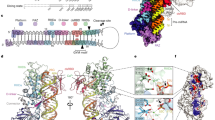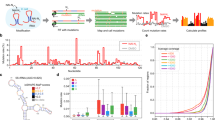Abstract
Dicer has a central role in RNA-interference pathways by cleaving double-stranded RNAs (dsRNAs) to produce small regulatory RNAs. Human Dicer can process long double-stranded and hairpin precursor RNAs to yield short interfering RNAs (siRNAs) and microRNAs (miRNAs), respectively. Previous studies have shown that pre-miRNAs are cleaved more rapidly than pre-siRNAs in vitro and are the predominant natural Dicer substrates. We have used EM and single-particle analysis of Dicer–RNA complexes to gain insight into the structural basis for human Dicer's substrate preference. Our studies show that Dicer traps pre-siRNAs in a nonproductive conformation, whereas interactions of Dicer with pre-miRNAs and dsRNA-binding proteins induce structural changes in the enzyme that enable productive substrate recognition in the central catalytic channel. These findings implicate RNA structure and cofactors in determining substrate recognition and processing efficiency by human Dicer.
This is a preview of subscription content, access via your institution
Access options
Subscribe to this journal
Receive 12 print issues and online access
$189.00 per year
only $15.75 per issue
Buy this article
- Purchase on Springer Link
- Instant access to full article PDF
Prices may be subject to local taxes which are calculated during checkout







Similar content being viewed by others
References
Bernstein, E., Caudy, A.A., Hammond, S.M. & Hannon, G.J. Role for a bidentate ribonuclease in the initiation step of RNA interference. Nature 409, 363–366 (2001).
Carmell, M.A. & Hannon, G.J. RNase III enzymes and the initiation of gene silencing. Nat. Struct. Mol. Biol. 11, 214–218 (2004).
Macrae, I.J. et al. Structural basis for double-stranded RNA processing by Dicer. Science 311, 195–198 (2006).
MacRae, I.J., Zhou, K. & Doudna, J.A. Structural determinants of RNA recognition and cleavage by Dicer. Nat. Struct. Mol. Biol. 14, 934–940 (2007).
Park, J.E. et al. Dicer recognizes the 5′ end of RNA for efficient and accurate processing. Nature 475, 201–205 (2011).
Tomari, Y. & Zamore, P.D. Perspective: machines for RNAi. Genes Dev. 19, 517–529 (2005).
Calabrese, J.M., Seila, A.C., Yeo, G.W. & Sharp, P.A. RNA sequence analysis defines Dicer's role in mouse embryonic stem cells. Proc. Natl. Acad. Sci. USA 104, 18097–18102 (2007).
Chiang, H.R. et al. Mammalian microRNAs: experimental evaluation of novel and previously annotated genes. Genes Dev. 24, 992–1009 (2010).
Ma, E., MacRae, I.J., Kirsch, J.F. & Doudna, J.A. Autoinhibition of human dicer by its internal helicase domain. J. Mol. Biol. 380, 237–243 (2008).
Chakravarthy, S., Sternberg, S.H., Kellenberger, C.A. & Doudna, J.A. Substrate-specific kinetics of Dicer-catalyzed RNA processing. J. Mol. Biol. 404, 392–402 (2010).
Lee, H.Y. & Doudna, J.A. TRBP alters human precursor microRNA processing in vitro. RNA 18, 2012–2019 (2012).
Noland, C.L., Ma, E. & Doudna, J.A. siRNA repositioning for guide strand selection by human Dicer complexes. Mol. Cell 43, 110–121 (2011).
Gregory, R.I., Chendrimada, T.P., Cooch, N. & Shiekhattar, R. Human RISC couples microRNA biogenesis and posttranscriptional gene silencing. Cell 123, 631–640 (2005).
Welker, N.C. et al. Dicer's helicase domain discriminates dsRNA termini to promote an altered reaction mode. Mol. Cell 41, 589–599 (2011).
Tsutsumi, A., Kawamata, T., Izumi, N., Seitz, H. & Tomari, Y. Recognition of the pre-miRNA structure by Drosophila Dicer-1. Nat. Struct. Mol. Biol. 18, 1153–1158 (2011).
Ma, E., Zhou, K., Kidwell, M.A. & Doudna, J.A. Coordinated activities of human dicer domains in regulatory RNA processing. J. Mol. Biol. 422, 466–476 (2012).
Lau, P.W., Potter, C.S., Carragher, B. & MacRae, I.J. Structure of the human Dicer-TRBP complex by electron microscopy. Structure 17, 1326–1332 (2009).
Wang, H.W. et al. Structural insights into RNA processing by the human RISC-loading complex. Nat. Struct. Mol. Biol. 16, 1148–1153 (2009).
Lau, P.W. et al. The molecular architecture of human Dicer. Nat. Struct. Mol. Biol. 19, 436–440 (2012).
Danev, R. & Nagayama, K. Transmission electron microscopy with Zernike phase plate. Ultramicroscopy 88, 243–252 (2001).
Danev, R. & Nagayama, K. Single particle analysis based on Zernike phase contrast transmission electron microscopy. J. Struct. Biol. 161, 211–218 (2008).
Shigematsu, H., Sokabe, T., Danev, R., Tominaga, M. & Nagayama, K. A 3.5-nm structure of rat TRPV4 cation channel revealed by Zernike phase-contrast cryoelectron microscopy. J. Biol. Chem. 285, 11210–11218 (2010).
Shimada, A. et al. Curved EFC/F-BAR-domain dimers are joined end to end into a filament for membrane invagination in endocytosis. Cell 129, 761–772 (2007).
Yamaguchi, M., Danev, R., Nishiyama, K., Sugawara, K. & Nagayama, K. Zernike phase contrast electron microscopy of ice-embedded influenza A virus. J. Struct. Biol. 162, 271–276 (2008).
Murata, K. et al. Zernike phase contrast cryo-electron microscopy and tomography for structure determination at nanometer and subnanometer resolutions. Structure 18, 903–912 (2010).
Haase, A.D. et al. TRBP, a regulator of cellular PKR and HIV-1 virus expression, interacts with Dicer and functions in RNA silencing. EMBO Rep. 6, 961–967 (2005).
Danev, R., Glaeser, R.M. & Nagayama, K. Practical factors affecting the performance of a thin-film phase plate for transmission electron microscopy. Ultramicroscopy 109, 312–325 (2009).
MacRae, I.J. & Doudna, J.A. An unusual case of pseudo-merohedral twinning in orthorhombic crystals of Dicer. Acta Crystallogr. D Biol. Crystallogr. 63, 993–999 (2007).
Kelley, L.A. & Sternberg, M.J. Protein structure prediction on the Web: a case study using the Phyre server. Nat. Protoc. 4, 363–371 (2009).
Luo, D. et al. Structural insights into RNA recognition by RIG-I. Cell 147, 409–422 (2011).
Scheres, S.H. et al. Disentangling conformational states of macromolecules in 3D-EM through likelihood optimization. Nat. Methods 4, 27–29 (2007).
Roberts, A.J. et al. AAA+ Ring and linker swing mechanism in the dynein motor. Cell 136, 485–495 (2009).
Cianfrocco, M.A. et al. Human TFIID binds to core promoter DNA in a reorganized structural state. Cell 152, 120–131 (2013).
MacRae, I.J., Ma, E., Zhou, M., Robinson, C.V. & Doudna, J.A. In vitro reconstitution of the human RISC-loading complex. Proc. Natl. Acad. Sci. USA 105, 512–517 (2008).
Giraldez, A.J. et al. Zebrafish MiR-430 promotes deadenylation and clearance of maternal mRNAs. Science 312, 75–79 (2006).
Daniels, S.M. et al. Characterization of the TRBP domain required for dicer interaction and function in RNA interference. BMC Mol. Biol. 10, 38 (2009).
Radermacher, M., Wagenknecht, T., Verschoor, A. & Frank, J. Three-dimensional reconstruction from a single-exposure, random conical tilt series applied to the 50S ribosomal subunit of Escherichia coli. J. Microsc. 146, 113–136 (1987).
Kim, D.H. et al. Synthetic dsRNA Dicer substrates enhance RNAi potency and efficacy. Nat. Biotechnol. 23, 222–226 (2005).
Nam, Y., Chen, C., Gregory, R.I., Chou, J.J. & Sliz, P. Molecular basis for interaction of let-7 microRNAs with Lin28. Cell 147, 1080–1091 (2011).
Michlewski, G. & Cáceres, J.F. Antagonistic role of hnRNP A1 and KSRP in the regulation of let-7a biogenesis. Nat. Struct. Mol. Biol. 17, 1011–1018 (2010).
Mayr, F., Schütz, A., Döge, N. & Heinemann, U. The Lin28 cold-shock domain remodels pre-let-7 microRNA. Nucleic Acids Res. 40, 7492–7506 (2012).
Gu, S. et al. The loop position of shRNAs and pre-miRNAs is critical for the accuracy of dicer processing in vivo. Cell 151, 900–911 (2012).
Cenik, E.S. et al. Phosphate and R2D2 restrict the substrate specificity of Dicer-2, an ATP-driven ribonuclease. Mol. Cell 42, 172–184 (2011).
Zhang, H., Kolb, F.A., Brondani, V., Billy, E. & Filipowicz, W. Human Dicer preferentially cleaves dsRNAs at their termini without a requirement for ATP. EMBO J. 21, 5875–5885 (2002).
Cifuentes, D. et al. A novel miRNA processing pathway independent of Dicer requires Argonaute2 catalytic activity. Science 328, 1694–1698 (2010).
Cheloufi, S., Dos Santos, C.O., Chong, M.M. & Hannon, G.J.A. Dicer-independent miRNA biogenesis pathway that requires Ago catalysis. Nature 465, 584–589 (2010).
Ludtke, S.J., Baldwin, P.R. & Chiu, W. EMAN: semiautomated software for high-resolution single-particle reconstructions. J. Struct. Biol. 128, 82–97 (1999).
van Heel, M., Harauz, G., Orlova, E.V., Schmidt, R. & Schatz, M. A new generation of the IMAGIC image processing system. J. Struct. Biol. 116, 17–24 (1996).
Hosokawa, F., Danev, R., Arai, Y. & Nagayama, K. Transfer doublet and an elaborated phase plate holder for 120 kV electron-phase microscope. J. Electron Microsc. (Tokyo) 54, 317–324 (2005).
Frank, J. et al. SPIDER and WEB: processing and visualization of images in 3D electron microscopy and related fields. J. Struct. Biol. 116, 190–199 (1996).
Scheres, S.H., Núñez-Ramírez, R., Sorzano, C.O., Carazo, J.M. & Marabini, R. Image processing for electron microscopy single-particle analysis using XMIPP. Nat. Protoc. 3, 977–990 (2008).
Tang, G. et al. EMAN2: an extensible image processing suite for electron microscopy. J. Struct. Biol. 157, 38–46 (2007).
Hohn, M. et al. SPARX, a new environment for cryo-EM image processing. J. Struct. Biol. 157, 47–55 (2007).
Wiedenheft, B. et al. Structures of the RNA-guided surveillance complex from a bacterial immune system. Nature 477, 486–489 (2011).
Ogura, T., Iwasaki, K. & Sato, C. Topology representing network enables highly accurate classification of protein images taken by cryo electron-microscope without masking. J. Struct. Biol. 143, 185–200 (2003).
Voss, N.R. et al. A toolbox for ab initio 3-D reconstructions in single-particle electron microscopy. J. Struct. Biol. 169, 389–398 (2010).
Lander, G.C. et al. Appion: an integrated, database-driven pipeline to facilitate EM image processing. J. Struct. Biol. 166, 95–102 (2009).
Voss, N.R., Yoshioka, C.K., Radermacher, M., Potter, C.S. & Carragher, B. DoG Picker and TiltPicker: software tools to facilitate particle selection in single particle electron microscopy. J. Struct. Biol. 166, 205–213 (2009).
Scheres, S.H. et al. Maximum-likelihood multi-reference refinement for electron microscopy images. J. Mol. Biol. 348, 139–149 (2005).
Acknowledgements
We thank W. Filipowicz (Friedrich Miescher Institute for Biomedical Research, Basel, Switzerland) for antibodies to human Dicer; A. Giraldez (Department of Genetics, Yale University School of Medicine, New Haven, Connecticut, USA) for purified pre-miR-430; G. Lander, P. Grob and T. Houweling for expert EM and image-processing assistance; A. Brewster for help with creating the homology model of human Dicer; T. Albergo for help with particle picking; members of the Wang, Doudna, Nagayama and Nogales labs for helpful discussions; A. Giraldez, D. Cifuentes, A. Bazzini, S. Baserga, J. Steitz and members of the Giraldez and Baserga labs for discussion and expert technical assistance; H. Okawara and M. Ohara (Division of Nano-Structure Physiology, Okazaki Institute for Integrative Bioscience, Okazaki, Japan) for preparing the Zernike phase plates; and the Yale Center for Cellular and Molecular Imaging and Yale Center for High Performance Computation in Biology and Medicine. D.W.T. is supported as a US National Science Foundation (NSF) Graduate Research Fellow and as an NSF and Japan Society for the Promotion of Science East Asia and Pacific Summer Institute Fellow. This work was supported in part by US National Institutes of Health (NIH) molecular biophysics training grant 5 T32 GM008283 (D.W.T.), the Core Research for Evolutional Science and Technology of Japan Science and Technology Agency (K.N.), NIH 5R01GM073794 (J.A.D.), Human Frontiers in Science Program RPG0039/2008-C (E.N.), the Smith Family Awards Program for Excellence in Biomedical Research (H.-W.W.) and National Natural Science Foundation of China 31270765 (H.-W.W.). J.A.D. and E.N. are supported as Howard Hughes Medical Institute Investigators.
Author information
Authors and Affiliations
Contributions
D.W.T. performed all E.M. and single-particle analysis. E.M. performed protein and RNA purification. H.S. performed ZPC-cryo-EM, supervised by K.N. M.A.C. and E.N. assisted with focused classification. C.L.N. purified Dicer–PACT complex. D.W.T., J.A.D. and H.-W.W. planned the experiments and wrote the manuscript. All authors analyzed and interpreted data and provided comments on the manuscript.
Corresponding authors
Ethics declarations
Competing interests
The authors declare no competing financial interests.
Supplementary information
Supplementary Text and Figures
Supplementary Figures 1–7, Supplementary Tables 1 and 2, and Supplementary Note (PDF 4478 kb)
Rights and permissions
About this article
Cite this article
Taylor, D., Ma, E., Shigematsu, H. et al. Substrate-specific structural rearrangements of human Dicer. Nat Struct Mol Biol 20, 662–670 (2013). https://doi.org/10.1038/nsmb.2564
Received:
Accepted:
Published:
Issue Date:
DOI: https://doi.org/10.1038/nsmb.2564
This article is cited by
-
Oligonucleotide therapeutics and their chemical modification strategies for clinical applications
Journal of Pharmaceutical Investigation (2024)
-
Structural insights into dsRNA processing by Drosophila Dicer-2–Loqs-PD
Nature (2022)
-
Cofactor-assisted dicing: insights from structural snapshots
Cell Research (2022)
-
RNA and DNA G-quadruplexes bind to human dicer and inhibit its activity
Cellular and Molecular Life Sciences (2021)
-
The RNA–RNA base pairing potential of human Dicer and Ago2 proteins
Cellular and Molecular Life Sciences (2020)



